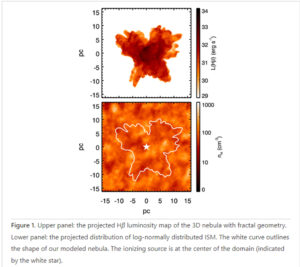PhD student Yifei Jin from our ANU node and his colleagues have published a letter in the Astrophysical Journal on emission line nebulae and high redshift galaxies.
What do Mandelbrot sets and high school chemistry experiments have in common? One is a fractal, and one is the study of emission lines from excited atoms.
For the first time, ASTRO 3D scientist PhD student Yifei Jin has created a model of the gases between stars using fractal geometry of photoionisations models to allow new interpretations of observed distant galaxies.
Perhaps you remember doing flame tests in chemistry class at school. Solutions containing different metals are squirted into a Bunsen burner, and the flames change colour. This same principle is work in the gas between stars.
Stars emit a continuum of many colours. Other objects, such as the gas between stars, emit sharp lines of only certain colours. These emitted lines (known as emission lines) tell us that the gas has been excited by something energetic nearby, such as stars. However, the geometry of the complex nebulae influences the optical emission lines that we see.
Current models assume a spherical, smooth geometry when considering photoionisation, rather than what we now know to be highly turbulent environments. Using M82 and the Antennae galaxies, which are dense and compact, and have star-forming regions, a fractal density field was modelled to show structure and density fluctuations similar to real turbulent molecular clouds.

This more complex model takes into account electron temperature, electron density, ionisation states of different elements by using detailed stellar atmosphere models as the input ionising source.
Read the original letter here: https://iopscience.iop.org/article/10.3847/2041-8213/ac80f3